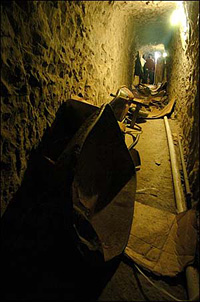 |
 |
 |
 News from Around the Americas | May 2007 News from Around the Americas | May 2007  
Cement Poured to Plug Tunnel Under US-Mexico Border
 Associated Press Associated Press


| | Investigators found two tons of marijuana at the Mexican end of this sophisticated cross-border tunnel that led to an industrial building in Otay Mesa, it was reported in January, 2006. (AP/David Maung) |
San Diego - A small fleet of cement mixers began pouring concrete this week to plug the longest secret tunnel ever discovered along the U.S.-Mexico border.

The 2,400-foot passage connected a warehouse near the Tijuana, Mexico, airport to a small office inside a warehouse in Otay Mesa, a San Diego industrial district within sight of the border fence.

The stretch running under U.S. soil – about 2,100 feet, or the length of seven football fields – is being filled to prevent smugglers and traffickers from accessing any portion of the passage.

Contractors are using a type of cement that isn't strong enough to be used as a tunnel wall, said Rich McMahan, a project manager for U.S. Customs and Border Protection.

Before the giant passage was discovered, standard practice had been to simply block tunnel entrances. Authorities have found 53 underground passages of varied degrees of sophistication since they increased surveillance after the Sept. 11, 2001 attacks.

Mexican agents found 2 tons of marijuana inside the tunnel after finding a cement shaft inside a warehouse just south of the border in January 2006. A cement shaft 10 feet wide and 7 feet long dropped nearly 80 feet to a tunnel that authorities described as the most sophisticated clandestine passage they had ever seen.

The full length was lined and equipped with pulleys, electrical wiring and water pumps.

Federal investigators believe the tunnel was built by Mexican workers for the Tijuana-based Arellano Felix drug cartel and may have been in use for several months before it was discovered.

"I would be astounded if there were not other tunnels out there," said Frank Marwood, a special agent for U.S. Immigration and Customs Enforcement. "But I don't think we have interstate system underground yet, at least I hope not."

In the past year, federal and military agencies have begun sharing more intelligence and data collected from underground sensors that can pick up digging sounds, Marwood said.

At least six other tunnels considered at risk of use by smugglers are scheduled to be filled over the next two months, at a cost of $2.7 million. The tunnels include one at San Diego's San Ysidro border crossing, three in Calexico, about 120 miles east of San Diego, and two in Nogales, Ariz. | 
 | |
 |



